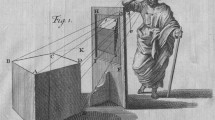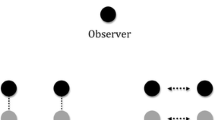Abstract
In this paper I contrast the geometric structure of phenomenal visual space with that of photographic images. I argue that topologically both are two-dimensional and that both involve central projections of scenes being depicted. However, I also argue that the metric structures of the spaces differ inasmuch as two types of “apparent distortions”—marginal distortion in wide-angle photography and close-up distortions—which occur in photography do not occur in the corresponding visual experiences. In particular, I argue that the absence of marginal distortions in vision is evidence for a holistic metric of visual space that is spherical, and that the absence of close-up distortions shows that the local metric structure possesses a dynamic variable curvature which is dependent upon the distance away of objects being viewed at a given time.






Similar content being viewed by others
References
Austin J (1962) Sense and sensibilia. Oxford University Press, Oxford
Chisholm R (1957) Perceiving: a philosophical study. Cornell University Press, New York
Clerc L (1970) Photography theory and practice. Focal Press Ltd, New York
Descartes R (1641/1911) Meditations. In: Haldane E, Ross G (ed) The philosophical works of Descartes. Cambridge University Press, Cambridge
French R (1987a) The geometry of vision and the mind body problem. Peter Lang, New York
French R (1987b) The geometry of visual space. Nous 21:115–133
Gilinsky A (1955) The effect of attitude upon the perception of size. Am J Psychol 68:173–192
Goodman N (1976) Languages of art. Hackett Publishing Co., Indianapolis
Matthen M (2005) Seeing, doing, and knowing. Oxford University Press, Oxford
Menger K (1943) What is dimension? Am Math Mon 50:2–7
Poincaré H (1963) Dernières Pensées, translated by John Bolduc. Dover Publications, New York
Pylyshyn Z (2003) Seeing and visualizing. MIT Press, Cambridge
Reid T (1764/1997) An inquiry into the human mind. Edinburgh University Press, Edinburgh
Smith A (2000) Space and sight. Mind 109:481–518
Smythies J (1994) The walls of Plato’s cave. Avebury, Surrey
Thouless R (1931) Phenomenal regression to the real object, I. Brit J Psychol 21:339–359
Upton B, Upton J (1985) Photography, 3rd edn. Little Brown, Boston
Walsh V, Kulikowski J (1998) Perceptual constancy. Cambridge University Press, Cambridge
White J (1958) The birth and rebirth of pictorial space. Thomas Yoseloff, New York
Author information
Authors and Affiliations
Corresponding author
Rights and permissions
About this article
Cite this article
French, R. Apparent Distortions in Photography and the Geometry of Visual Space. Topoi 35, 523–529 (2016). https://doi.org/10.1007/s11245-015-9316-5
Published:
Issue Date:
DOI: https://doi.org/10.1007/s11245-015-9316-5




